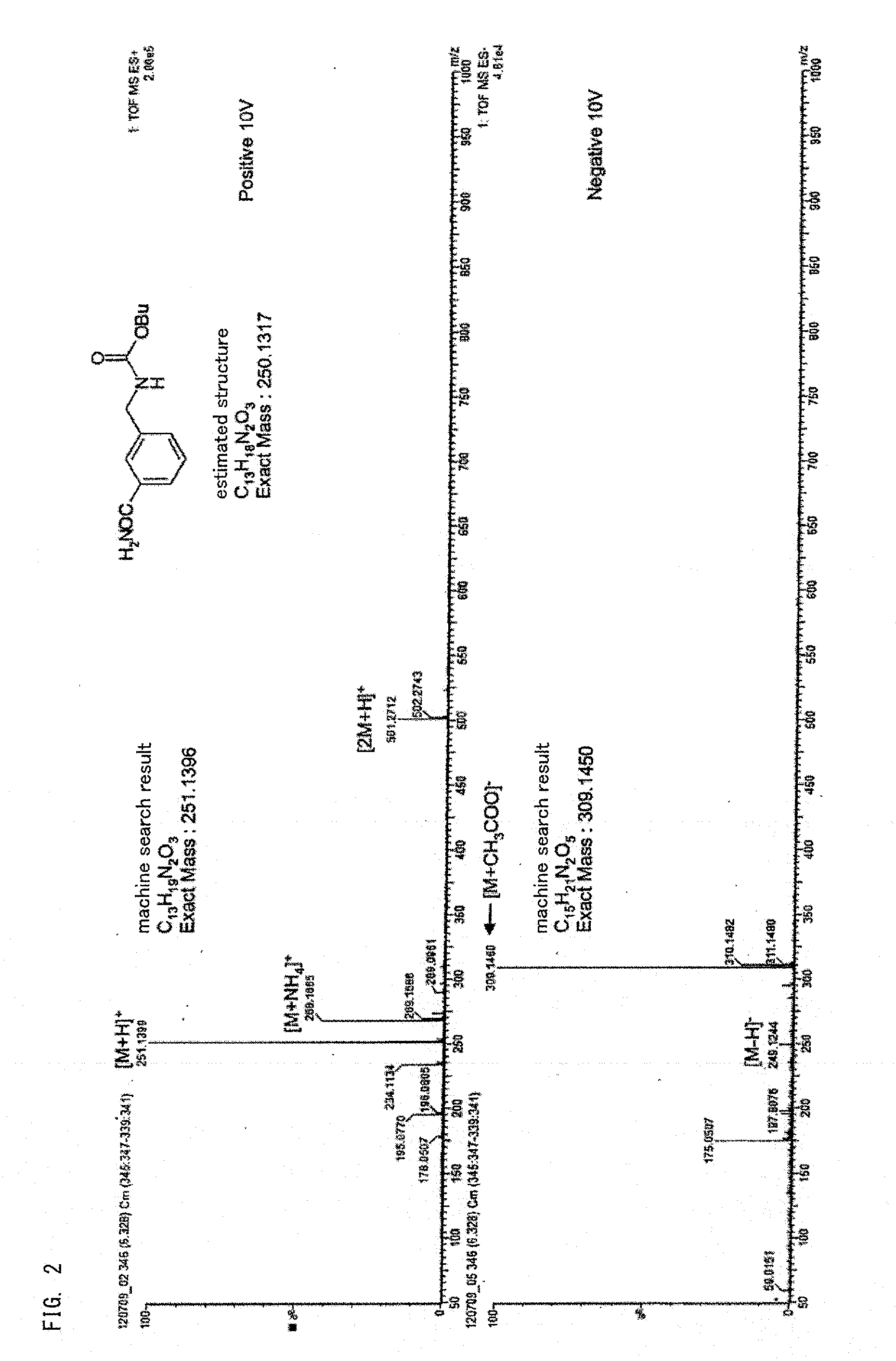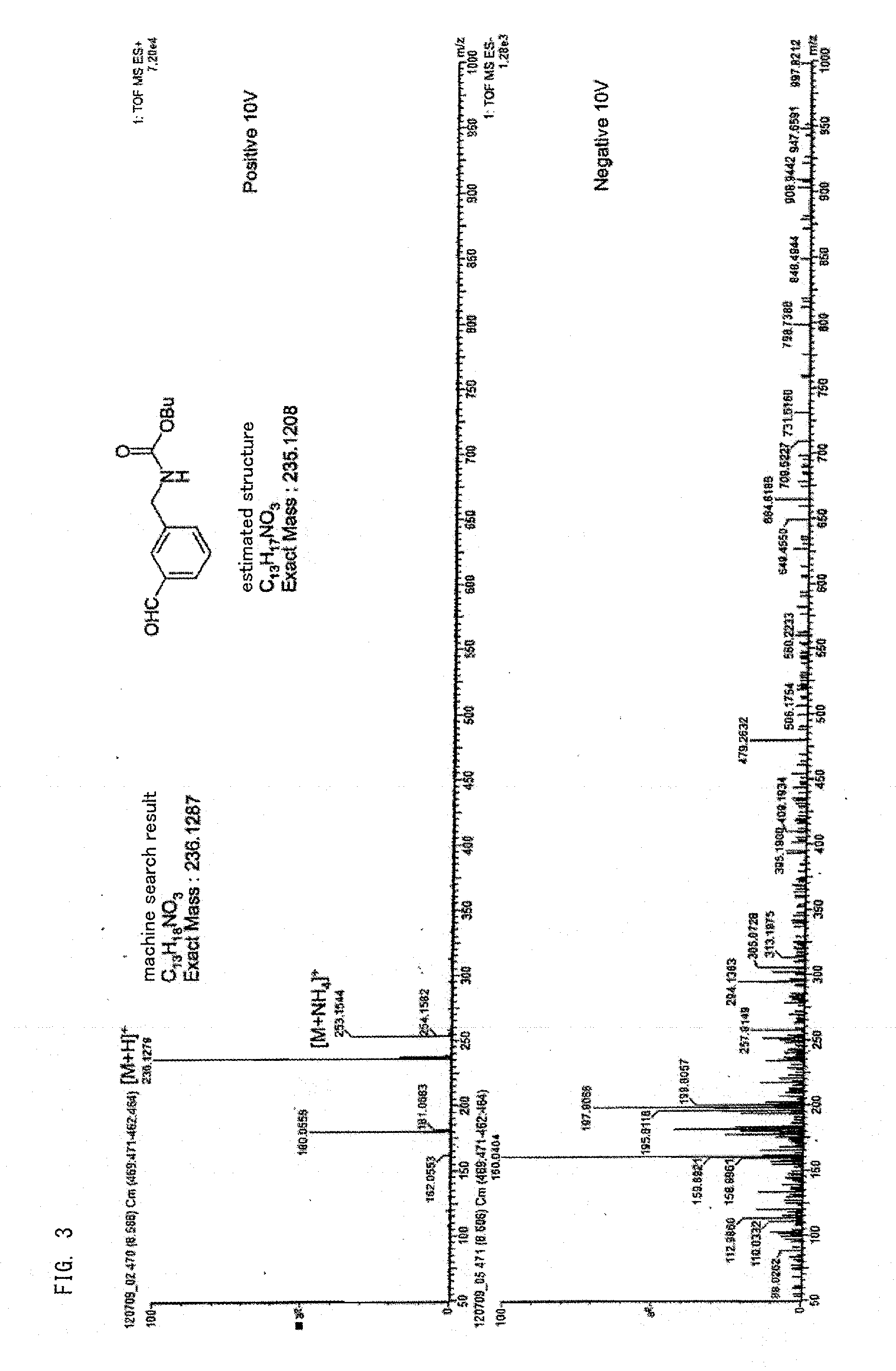Xylylene dicarbamate, method for producing xylylene diisocyanate, xylylene diisocyanate, and method for reserving xylylene dicarbamate
a technology of xylylene dicarbamate and xylylene diisocyanate, which is applied in the preparation of isocyanic acid derivatives, organic chemistry, carbamic acid derivatives, etc., can solve the problems of high toxicity, disadvantageous handling, and strong corrosion of phosgene, and achieve high yield and high quality. , the effect of high yield
- Summary
- Abstract
- Description
- Claims
- Application Information
AI Technical Summary
Benefits of technology
Problems solved by technology
Method used
Image
Examples
example 1
Xylylene Dicarbamate
[0112]1,3-xylylene dicarbamate was put into a heat-resistant vessel and the total amount of impurities (the compound represented by the above-described formulas (1) to (4)) in the 1,3-xylylene dicarbamate was obtained with high performance liquid chromatography. As a result, the impurity content was 0 ppm. A case where the impurity content was less than the detection limit (less than 1 ppm) with the high performance liquid chromatography was defined as 0 ppm (hereinafter, the same).
[0113]Next, the above-described heat-resistant vessel was filled with a high-purity nitrogen gas having a purity of 99.999% by volume. At this time, the total oxygen amount of the oxygen amount contained in a space portion of the vessel of the 1,3-xylylene dicarbamate and the oxygen amount dissolved in the xylylene dicarbamate relative to the xylylene dicarbamate was 10 ppm.
[0114]The oxygen amount was calculated by measuring a vapor phase portion and a xylylene dicarbamate portion (liq...
example 2
Xylylene Dicarbamate
[0125]1,3-xylylene dicarbamate was reserved in the same manner as that in Example 1, except that the reserving time was changed to 24 hours. Thereafter, the total amount of impurities (the compound represented by the above-described formulas (1) to (4)) in the 1,3-xylylene dicarbamate was obtained. As a result, the impurity content was 40 ppm.
[0126]
[0127]The above-described xylylene dicarbamate after storage was thermally decomposed to obtain a product containing xylylene diisocyanate and alcohol in the same manner as that in Example 1. Thereafter, the obtained product was partially eliminated as a vapor component and the remainder was condensed to obtain a condensate.
[0128]The xylylene dicarbamate conversion rate in the above-described thermal decomposition reaction determined by the same manner as that in Example 1 was 99 mol %.
[0129]The xylylene diisocyanate yield determined by the same manner as that in Example 1 relative to the material xylylene dicarbamate ...
reference example 1
Xylylene Dicarbamate
[0150]The total amount of impurities (the compound represented by the above-described formulas (1) to (4)) in the 1,3-xylylene dicarbamate was obtained in the same manner as that in Comparative Example 1, except that the 1,3-xylylene dicarbamate was used without being heated and reserved. As a result, the impurity content was 0 ppm.
[0151]
[0152]The above-described xylylene dicarbamate before heating and storage was thermally decomposed to obtain a product containing xylylene diisocyanate and alcohol in the same manner as that in Example 1. Thereafter, the obtained product was partially eliminated as a vapor component and the remainder was condensed to obtain a condensate.
[0153]The xylylene dicarbamate conversion rate in the above-described thermal decomposition reaction determined by the same manner as that in Example 1 was 99 mol %.
[0154]The xylylene diisocyanate yield determined by the same manner as that in Example 1 relative to the material xylylene dicarbamat...
PUM
| Property | Measurement | Unit |
|---|---|---|
| melting point | aaaaa | aaaaa |
| time | aaaaa | aaaaa |
| time | aaaaa | aaaaa |
Abstract
Description
Claims
Application Information
 Login to View More
Login to View More - R&D
- Intellectual Property
- Life Sciences
- Materials
- Tech Scout
- Unparalleled Data Quality
- Higher Quality Content
- 60% Fewer Hallucinations
Browse by: Latest US Patents, China's latest patents, Technical Efficacy Thesaurus, Application Domain, Technology Topic, Popular Technical Reports.
© 2025 PatSnap. All rights reserved.Legal|Privacy policy|Modern Slavery Act Transparency Statement|Sitemap|About US| Contact US: help@patsnap.com



